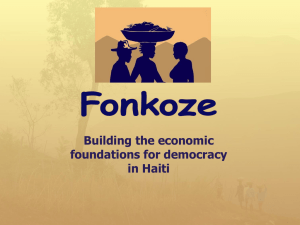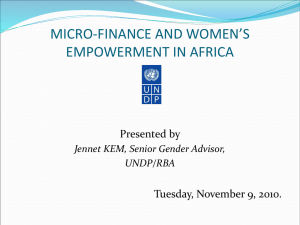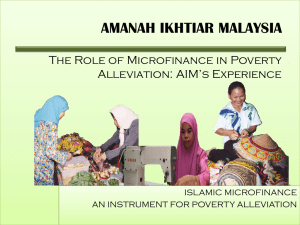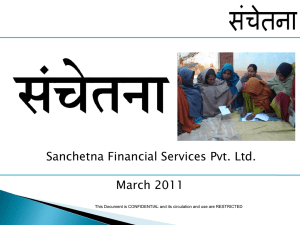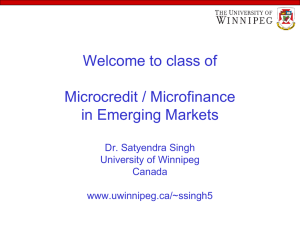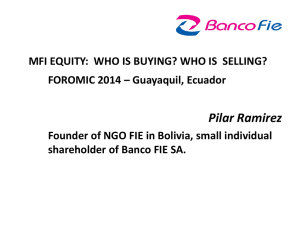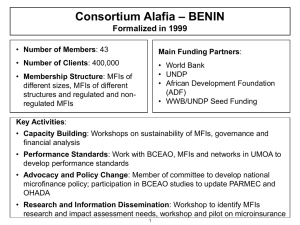a. Microfinance Policies & Infrastructure
advertisement
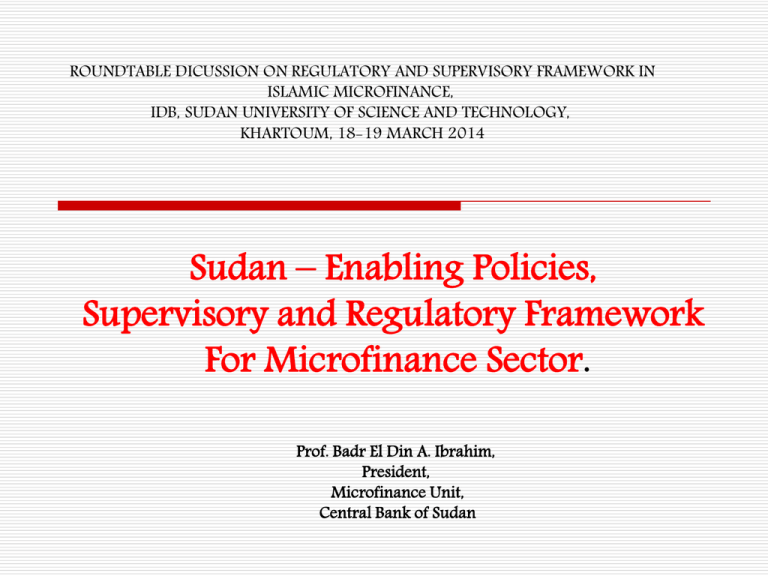
ROUNDTABLE DICUSSION ON REGULATORY AND SUPERVISORY FRAMEWORK IN ISLAMIC MICROFINANCE, IDB, SUDAN UNIVERSITY OF SCIENCE AND TECHNOLOGY, KHARTOUM, 18-19 MARCH 2014 Sudan – Enabling Policies, Supervisory and Regulatory Framework For Microfinance Sector. Prof. Badr El Din A. Ibrahim, President, Microfinance Unit, Central Bank of Sudan Contents Introduction Pillars of the enabling policies, supervisory & regulatory framework Microfinance Policies % Infrastructure Microfinance Institutional Framework Microfinance Strategies Financial inclusion and poverty alleviation Sudan MF Regulatory Framework- What is new? What is missing? Actions required. Introduction The Sudanese Islamic, central bank-led microfinance regulation and supervision practice, based on gap & needfilling, managed to produce a (1) full-fledged and (2) nationally integrated Islamic microfinance regulatory model. This model is described by the World Bank's Consultative Group to Assist the Poor (CGAP) as : "A laboratory for Islamic microfinance delivery where developments could shed light on effective Islamic microfinance practices". CGAP, 2013, "Trends in Sharia-Compliant Financial Inclusion", Consultative Group to Help the Poor, CGAP, The World Bank, Focus Note, No. 84, March Moreover, the IMF in its 2013 Article of Consultation stated that: “The microfinance sector is small but growing rapidly, thanks to the authorities’ active promotion. The results of this push have been impressive to date. The number of MF borrowers went from 49,000 at end-2007 to 494,000 by 2012. In terms of active clients, Sudan and Bangladesh are easily the global leaders in Islamic finance microfinance, with Sudan likely to take top spot given current growth rates” (Sudan: 2013 Article IV Consultation Staff Report; IMF Country Report 13/317; September 5, 2013) Pillars of the enabling policies, supervisory & regulatory framework a. Microfinance Policies & Infrastructure: In 1994/95: incorporation of “Craftsmen, Professionals & Small Producers, Including the Productive Families” as a priority sector for financing, with some preferential treatments MF was recognized as a priority sector, with a minimum allocation of 12% of the banking portfolio. a Regulatory and Supervisory Framework to establish microfinance institutions was issued in 2011. Identification of 15 types of guarantees suitable for this sector. Identification of Islamic lending modes of microfinance. Announcement of the Comprehensive Insurance Documents to act as insurance & a guarantee Establishment of the Wholesale Guarantee Agency (Kafalat) to guarantee wholesale finance from CBOS, donors and Commercial banks to the 23 licensed non-deposit taking MFIs. Provision of technical assistance to MFIs (in 2011b, a program with the Islamic Development Bank (IDB) to allocate $59.5 million joint fund for technical support, IT & wholesale finance to MFIs. A $ 20 million capital Sudanese Microfinance Development Facility (SMDF) to support MFIs via disseminations of best practices, technical assistance, training & wholesale financing. Reorganization of the government MF specialized banks (Saving & Social Development Bank & Agricultural bank) for more effective microfinance service delivery. b. Microfinance Institutional Framework Microfinance Unit at the CBO to overlook the financial sector. The Supreme Council of Microfinance (SCMF) headed by the First Vice-President and include all relevant state ministers Microfinance Project Development Centre (PDC) to encourage microfinance projects and to perform projects' feasibility studies in accordance with the comparative advantages. Microfinance units at the CBOS’ branches & commercial banks headquarters Project Planning Units (PPU) in 8 state ministries (function: feasibility studies of projects, provide technical information and perform annual plans to execute the ministry-related microfinance projects, and organize clients into groupings) c. Microfinance Strategies The CBOS strategy to promote the sector was made through the Vision for the Development & Expansion of MF Sector in Sudan -2007-2011. The vision includes: Conducive Legal & Policy Environment, Develop & Sustain MFIs & Establishing & Supportive Infrastructure The new Comprehensive National Microfinance Strategy (CNMS) cover up to 2017. This microfinance strategy will replace the CBoS strategy, and includes all microfinance stakeholders. The major expected outcome: increase contribution of MF sector to GDP from 1 to 3%, increase number of clients from 494000 to 1.5 mill. by 2017, Increase in the % of poor microfinance clients (18 years +) from 8.2% to 24.6%, & women clients from 30% to 50% Financial inclusion and poverty alleviation Khartoum state share 13% of the total MF clients, ranked after Gadarif state (18%), North Darfur state (14%), & North Kordofan state (13%), all are remote areas There is no consistent pattern of the relationship between the clients and the volume of finance at all states. Khartoum State came first with the share of 33%, Gezira state second (9%), then River Nile, Gadarif, and Sinnar (7%). A sizable finance is in Khartoum, the Capital, while the sizable numbers of clients were in other states. The degree of banks concentration: the average share of Khartoum state is 38.9% of the total branches during the period 1979-1987, reduced to 32.8% during the period 1997-2001, up to 41% in 2012. Other regions: The central region around 20%, eastern region around 12%, northern region around 10% recently, while western regions (Kordofan and Darfur) share less than 10% over the same period (regional inequality in the distribution of branches in towns and urban areas) MFIs: Out of 23 MFIs currently working, Khartoum state share only 5 MFIs With the exception of Khartoum and northern region, which are characterized by a relatively high average individual consumption of goods and services, other regions (Central, Eastern, Kordofan and Darfur, where the degree of banks' concentration collectively low) have less than the national average level of consumption. Darfur and Kordofan states, which have the lowest degree of banks' concentration in 2012 (below 10%), their average individual consumption of goods and services are the lowest The Sudanese Regulatory Framework: What is new? The first full-fledge CBOS-supported Islamic MF experience (licensing, following up, wholesale lending, capital sharing, HR up-grading, projects sponsorship). It is one of the first African countries that establish national MF Strategy including all stakeholders. The first African & Arab experience that determined a percentage of banking MF portfolio The first experience with national institutional support (SCMF, MFUs, MF Planning Units etc.) The first experience to include micro Takaful. introduce the wholesale via a governmental agency (Kafalat) and to exploit the restricted Mudarabah as a formula for microfinance wholesale lending What is missing? The Sudanese microfinance regulatory framework managed to set what is basically required to have many microfinance indicators move rapidly. The number of clients (Banks and MFIs) increased from 244000 in 2011 to 494000 in 2012 and to 700000 in 2013. The banking MF portfolio increased from 1% in 2007 to 5% in 2013. MFIs increased from 3 in 2007 to 23 in 2013. The MFIs’ NPL down from 6% in 2012 to 1.9% in 2013 Nevertheless misconceptions and gaps still exist MF is mainly viewed as intervention to reduce poverty & not integrated to the macroeconomic objectives. MF is viewed only as credit-based lending, with little use of micro-insurance, micro-saving, money transfer Most clients believe that credit before growth (finance is pre-requisite to the existence of the project itself). Some believe that MF profit margins ( Murabaha margin) should be centrally-controlled. MF is viewed microfinance as a charity lending, not a lucrative business (margins should be subsidized). MF providers believe that microfinance activities do not lead to institutional sustainability Most MF activities meet local-demand-oriented, not export oriented Actions Required Ensure a social development-oriented microfinance sector via regional equality of distribution of branches, heavy use of partnership-based modes. move toward the international performance measurement of banks/MFIs financial, administrative & social outcomes/ coordinate the strong national microfinance efforts,/guarantee clientprotection policy & mechanism/ ensure evidence-based MF polices/ diversify projects/ make heavy use of modern technology / ensure a full use of Islamic MF potential/ move towards export-orientated MF products / establish investment maps, & exhibitions / ensure real public awareness programs to remove misconceptions/ and provide financial literacy programs


